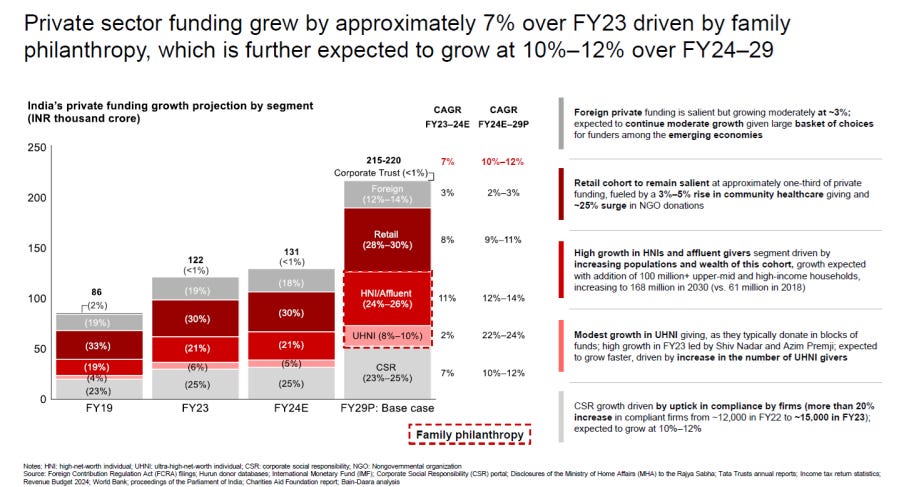Funding in the Development Sector – Trends and Implications
This is an extract from the India Philanthropy Report 2025, prepared by Bain and Dasra.
Notes:
1. Foreign funds, both institutional and individual. FCRA route.
2. Ultra High Net Worth (UHNI) – net worth INR 1,000 crores+. Typically contribute 0.1% of their wealth annually.
3. High Net Worth (HNI) – net worth INR 200 – 1,000 crores. Typically contributes 0.7% of their wealth annually.
4. Affluent – net worth INR 7 – 200 crores. A significant part of the Retail contributions.
5. CSR – 2% of the profit of companies fulfilling some conditions. Now, 15,000+ come into the ambit.
Key takeaways:
1. Foreign funding is coming down (all the changes in FCRA and scrutiny).
2. HNI and CSR funding are increasing.
3. UHNI and Retail funding are stable.
What does it mean for the NGOs? Here is an assessment of the implications:
Potential implications:
1. Fundraising becomes tougher (apart from CSR, almost all UHNIs and a few HNIs are setting up family offices).
2. Donors become more local, with a much better understanding of the situation in India. Consequently, higher scrutiny, even if passive.
3. Higher compliance for CSR, FCRA, and Income Tax as the government becomes more focused on ensuring better alignment of funds and causes.
4. Higher levels of reporting and higher accuracy.
The Non-Government sector has traditionally been driven by charismatic founders, who provided leadership through vision, and often loyalty. This has achieved great success, but often at the expense of lower compliance, and lack of scale beyond a limited geography.
The funds were often easy to get, especially from abroad, as India was seen as an underdeveloped country. Often an email with some photographs was enough for the flow.
This did great help, but the lax governance was also abused by many. Things, however, have changed over the years as India has become more economically stable, and the state's capacity for both support as well as ensuring compliance increases.
This is going to be the trend for now. We will see higher scrutiny in fundraising, project execution, reporting, and compliance. This is good for the sector. But this will need a different set of skills.
The development sector has been witnessing an inflow of members with exposure to professional management. Academic and other institutions have geared up to build these gaps. This will continue, and the sector will look for individuals who can align the vision to articulation, conceptualization, planning, execution, tracking, and reporting.
This has major implications for all who are engaged in the capacity development of the personnel.





